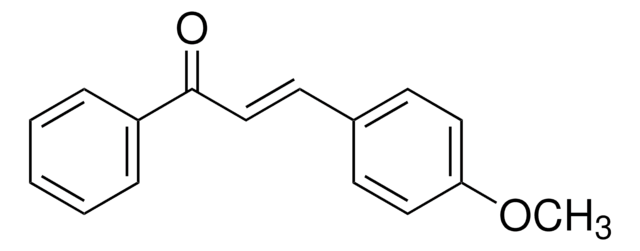W267007
p-Anisaldehyde
≥97.5%, FCC, FG
Sinónimos:
4-Methoxybenzaldehyde, Aubépine
About This Item
Productos recomendados
origen biológico
synthetic
grado
FG
Fragrance grade
Halal
Kosher
Agency
follows IFRA guidelines
meets purity specifications of JECFA
cumplimiento norm.
EU Regulation 1223/2009
EU Regulation 1334/2008 & 872/2012
FCC
FDA 21 CFR 172.515
densidad de vapor
4.7 (vs air)
Análisis
≥97.5%
formulario
liquid
composición
contains IFRA restricted p-Anisaldehyde
índice de refracción
n20/D 1.573 (lit.)
bp
248 °C (lit.)
mp
−1 °C (lit.)
densidad
1.119 g/mL at 25 °C (lit.)
aplicaciones
flavors and fragrances
Documentación
see Safety & Documentation for available documents
alérgeno alimentario
no known allergens
alérgeno de la fragancia
no known allergens
Organoléptico
anise; cherry; creamy; floral; balsamic; sweet; vanilla
cadena SMILES
[H]C(=O)c1ccc(OC)cc1
InChI
1S/C8H8O2/c1-10-8-4-2-7(6-9)3-5-8/h2-6H,1H3
Clave InChI
ZRSNZINYAWTAHE-UHFFFAOYSA-N
Información sobre el gen
human ... CYP1A2(1544)
¿Está buscando productos similares? Visita Guía de comparación de productos
Categorías relacionadas
Aplicación
- Aryl-alcohol oxidase involved in lignin degradation: a mechanistic study based on steady and pre-steady state kinetics and primary and solvent isotope effects with two alcohol substrates.: The study focuses on the mechanistic understanding of aryl-alcohol oxidase in lignin degradation, utilizing p-Anisaldehyde as a model substrate to investigate enzyme kinetics and isotope effects. (Ferreira et al., 2009).
Acciones bioquímicas o fisiológicas
Otras notas
Palabra de señalización
Warning
Frases de peligro
Consejos de prudencia
Clasificaciones de peligro
Aquatic Chronic 3 - Repr. 2
Código de clase de almacenamiento
10 - Combustible liquids
Clase de riesgo para el agua (WGK)
WGK 1
Punto de inflamabilidad (°F)
240.8 °F - closed cup
Punto de inflamabilidad (°C)
116 °C - closed cup
Certificados de análisis (COA)
Busque Certificados de análisis (COA) introduciendo el número de lote del producto. Los números de lote se encuentran en la etiqueta del producto después de las palabras «Lot» o «Batch»
¿Ya tiene este producto?
Encuentre la documentación para los productos que ha comprado recientemente en la Biblioteca de documentos.
Los clientes también vieron
Nuestro equipo de científicos tiene experiencia en todas las áreas de investigación: Ciencias de la vida, Ciencia de los materiales, Síntesis química, Cromatografía, Analítica y muchas otras.
Póngase en contacto con el Servicio técnico













